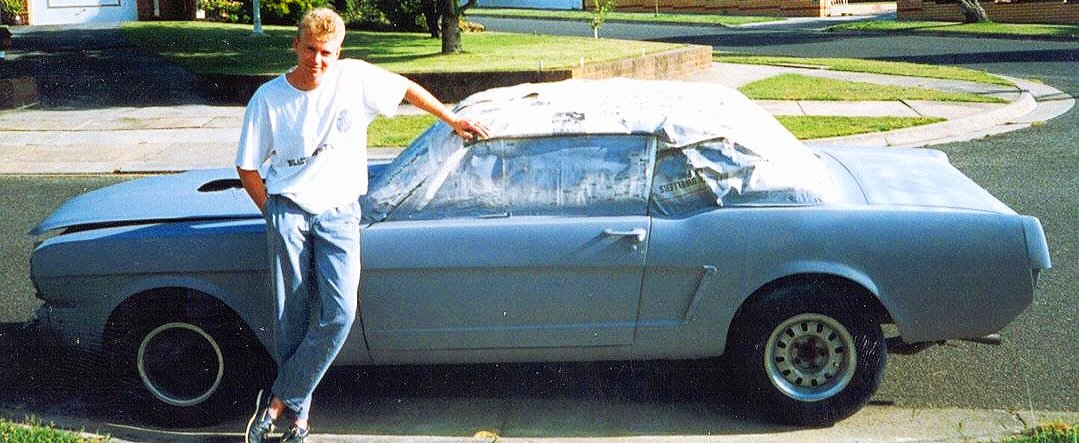About RAPH TRIPP, Tunnel Ram Founder
Growing up in 1970s Australia I was no more car mad than other kids, until my father started receiving weekly mail orders of New Yorker magazine. I’d flick through the pages to check out the car advertisements, every issue was packed with luxury car ads - Cadillac, Lincoln, Chrysler, Oldsmobile and Buick. The cars were enormous - land yachts with six foot long hoods, huge prominent grilles dripping with chrome, and interiors so warm and inviting you could live in them.
Posing with my ‘66 Tbird - one of the most beautifully styled of large American cars - with Ben Cunningham (right).
Usually set in exclusive surrounds such as country clubs and expensive hotels, the print ads accentuated exclusivity and luxury, taste and the good life. Beautiful people, sporty people, successful people invariably surrounded, sat in, or draped themselves across the desirable, glamorous machines. These ads weren’t just selling cars, they were selling a dream. It all looked so inviting, I wanted to transport my childhood self into these enticing worlds.
In the Australian summer of 1979/80 my family was driven to our holiday destination in a friend’s 1966 Pontiac Bonneville. Though the red duco was faded, and the styling undoubtedly dated, I got a taste of what it was like to waft along in a land yacht powered by a 6.5 litre V8. Spacious, comfortable, effortless. Now that was the way to travel. People stared as we passed through sleepy county towns - unused to seeing a Motown product in the flesh.
My first car was a 1967 Pontiac like the one above. It wasn’t quick - but boy was it a fun way to get around for my first summer on wheels.
Though the magazine ads were not intended for scruffy kids a million miles away, the Madison Avenue advertising agencies won me over. Yet, no sooner had my fascination developed than I began to realize I was witnessing the death of the Detroit dream machines.
From ‘77 the American cars in the ads became smaller, squarer - began to look European. More and more ads for Euro cars began to appear. Fuel economy and safety were major selling points. Before my eyes I was seeing the decline of American design influence, decline of the romance of motoring that held sway for so long. Replaced by safety consciousness, fuel economy, and practicality. Yawn.
I lost interest in the New Yorker ads. If I wanted to see a BMW/Mercedes/Audi/Volvo they were in city streets across Australia. Style was out, mileage was in, and I was left with only one place to go - the past.
Getting out on the open road in a classic car is a quick way to escape the hassles of life. At age twenty-one, I bought a beaten up 1965 Mustang hardtop like the one above.
I didn’t lose interest in American cars - the fire had been lit. It’s just that I had to look backwards - to the 1950s, 60s and early 70s. Chrome, glamour, pillarless styling, coke bottle hips, muscle and fury, GT stripes, hood scoops, power, romance...back to a time when cruising was king and the American car was at the epicentre of American culture.
I knew I wasn’t alone - a love of the road and car culture was there for all to hear in the music of the Beachboys, Bruce Springsteen, Neil Young, The Eagles and others. I bought the music, the books and magazines, watched the road movies - I was hooked.
Via the local products sold through America’s big three - General Motors Holden, Chrysler and Ford - we were lucky in Australia to share in the glory years with our very own homegrown muscle and luxury machines that oozed road presence. But in Oz too - we stopped looking to the US, and toward Europe.
The hugely successful Chrysler Valiant Charger - Detroit inspired, but Australia's own.
I sketched, dreamed, ogled, read about - cars cars cars. Later, when old enough to drive - I jumped in the deep end. Before my twentieth birthday I owned three - at the same time. A ‘72 Falcon V8 hardtop a-la Mad Max’s Interceptor, a worked Monaro GTS 350 4-speed missile, and a ‘67 Pontiac Parisienne. Later there was a ‘65 Mustang and a succession of 1970s Aussie Chryslers. Recently I owned a survivor ‘66 Tbird with the rare 428 V8.
Summertime and a long weekend with the boys working on my '65 Mustang hardtop - late 1980s
What to do with all the knowledge, the images and stories, the love of classic car culture?
I decided to create a site that would attempt to capture the fun, the excitement, the beauty - of classic and retro car culture of the 20th century. A place to browse the finest advertising images, of the best looking cars ever made. Tunnel Ram is about enjoying the best of it all, about having fun. An attempt to preserve something of the sheer love of movement, power, of the road... of freedom - that was at the heart of the high water mark of car culture.
If I’ve succeeded in getting just some of that across - it’s been worth it.
Visit, share, enjoy - Tunnel Ram
Raph Tripp
1974 HQ Holden GTS-350 Monaro - photo taken in 1986






